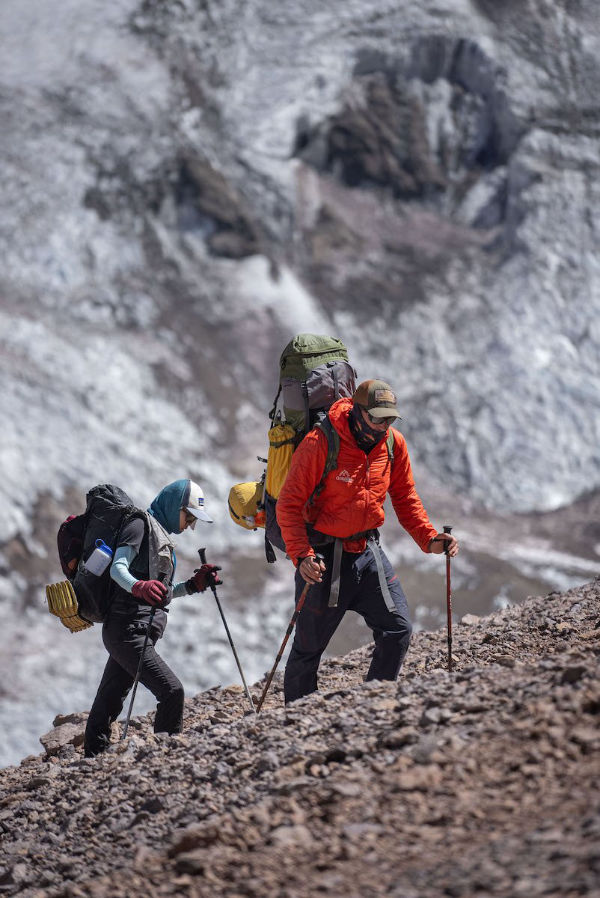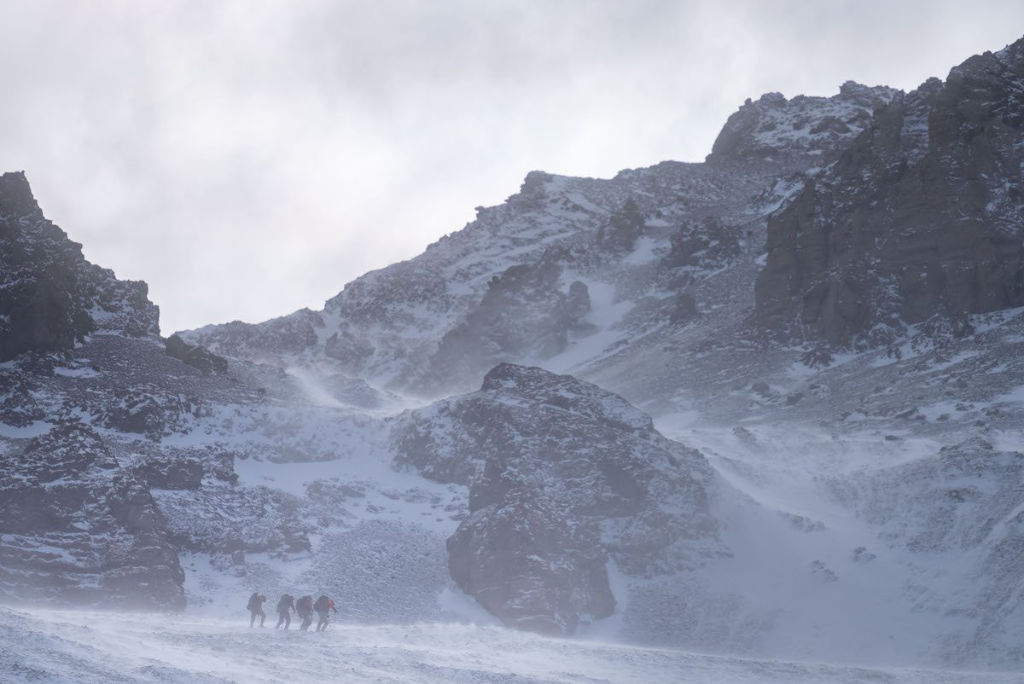We always tell our clients that reaching the summit of Aconcagua is truly the cherry on top, but it’s important to enjoy every layer of the cake. Being properly prepared for a summit attempt is the difference between an unforgettable experience and one you’d rather forget (not to mention, it’s much safer too). The cherry is delicious, but to reach it you’ll need proper training…
In the following paragraphs, we’ll dive into four essential elements for a solid training routine to climb Aconcagua, along with some suggested reading:
– What kind of aerobic training to focus on;
– Strength training specific to mountaineering;
– The importance of mobility exercises;
– Tips for psychological preparation.
When people decide to run a marathon, they spend months training specifically for it. Similarly, cyclists prepare for an epic ride train well in advance of the event. So, if you’re considering climbing a nearly 7,000-meter mountain, it makes perfect sense to train properly, right?
However, in my 22 years guiding on Mount Aconcagua, I’ve witnessed a surprising trend. Every year, climbers from around the world and all walks of life arrive in South America to face this high-altitude challenge. However, few are adequately prepared. Many are undoubtedly in good physical shape, but few have trained specifically for the unique demands of an 11-day climb over rocky terrain.
For most climbers, Aconcagua marks their first experience at high altitude, besides perhaps the Mount Kilimanjaro in Africa. While there’s little you can do to prepare for altitude itself, there is a lot you can do to physically and mentally prepare for the hypoxic conditions you’ll face. This includes building a strong aerobic base for sustained hiking, strength training to push through thousands of meters of elevation gain with a heavy backpack, mobility work to ensure efficient muscular function, and simulating summit day with long, challenging hikes.

Base Aerobic Training
AeT, Zone 2, aerobic threshold, nasal breathing, conversational pace, lactate level of 2 mmol/L. These are all terms you’ll come across when trying to understand key concepts in endurance training. With three 8-hour treks and a grueling 14-hour summit day, it’s clear that building your aerobic base is essential. At a minimum, 80% of your aerobic exercise should be done at this intensity.
From the site Training Peaks: “(Aerobic) Base training is simple: go at a pace just below your aerobic threshold (conversational pace) and stick with it.” Sounds simple enough. However, most people find keeping that pace boring and unexciting. So they think: “If you’re going to train, TRAIN HARD! You should be drenched in sweat and gasping for air.” Wrong! That’s the type of training you do during the other 20% of the time when you’re NOT training near your aerobic threshold. Making this mistake leads to fatigue, overtraining, and a lack of aerobic endurance.
Aerobic training is slow and monotonous. It’s not great for exciting Instagram photos, sorry. And yet, on so many physiological levels, it’s by far the best bang for your buck. For Aconcagua and for life. As the name suggests, it’s truly the foundation on which all your other exercises are based..
Also, keep in mind that you are training to climb a mountain. So this aerobic training should also be done on the steepest terrain possible. For those lucky enough to have hills or mountains nearby, try to rack up vertical meters whenever possible. People living in flat regions or cities will have to make do with stair climbers and treadmills with inclines of 15 to 30 percent.
Strength Training
Going to the gym is a binary experience—you either love it or hate it. Those in the latter group, however, will have to find a way to make it more enjoyable. Besides being an essential part of mountaineering preparation, it’s becoming increasingly clear that lifting weights has a long list of health benefits, especially for those of us over 45.

The most important block of training, after learning proper technique, is called “max-strength” training. It involves lifting loads for 3–5 reps, for 3–5 sets with a challenging weight. The set should end with “one rep in reserve”—that is, after doing your 3 to 5 reps, you should feel like you could have done just one more but didn’t.
When we want our muscles to grow (hypertrophy training), we do sets “to failure”—until we physically can’t lift anymore. But max-strength work is about making muscles stronger and more efficient without needing to add new muscle fibers that make us bulkier.
There are two main categories of strength exercises: compound and accessory. The first refers to movement patterns that engage various muscle groups and often involve two or three joints. Accessory exercises usually target a more specific muscle group. They require lighter loads and are most often added to support compound lifts to fix weaknesses, imbalances, or give extra stimulus to a particular area of the body.
The four main exercises I’ve found that work the largest number of muscle groups and are most useful for mountaineering are: squats, hip thrusts, Romanian deadlifts, and step-ups. If you add a few triceps pulls and various solid core exercises, you can build a very effective gym routine. Remember: learn proper technique (a few sessions with a personal trainer will pay off here), complete an appropriate adaptation phase, never increase your lifting weight more than 5–10% per week, push yourself but not to failure, balance your strength work with your aerobic training, and always allow for proper rest. That way, you’ll soar in the mountains!
Mobility Work
One of the best habits I’ve adopted recently is adding a 15-minute mobility routine at the start of my training sessions. Jay Dicharry, in Running Rewired, does a fantastic job explaining why this kind of dynamic warm-up and balance work is so important. One of the key concepts he mentions is what he calls “shut-down muscles.” These are muscles that, due to injury, poorly learned movement patterns, or lack of use, are inhibited and don’t fire properly. This, in turn, creates awkward, inefficient movement that puts unnecessary stress on other muscle groups that have to overcompensate to get the job done. Mobility work prepares the nervous system and re-engages muscles to allow for more uniform contractions and smoother movement. As Dicharry puts it, “this type of training targets muscular intelligence.”
I like to alternate between various mobility routines before doing strength work and a different set of routines before aerobic exercise. Each routine should include warm-up movements and others focused on balance and proprioception related to the workout you’re about to perform.

The Suffering Buffer
There’s one last topic I believe is worth covering, even if it involves a word no one likes to hear: suffering. You’ve done your homework. You’re physically fit, you’re strong, and thanks to your mobility work, you’re moving efficiently and pain-free. What else is there?
When I was in guide school, our director always emphasized the importance of training our “agonistics” (a word he made up)—our ability to withstand challenging situations.
High-altitude climbing can come with an uninspiring list of discomforts. Sleeping on an inflatable camping mattress is not the same as a cozy night on your favorite memory foam bed, and a windy night in a tent is not quite as picturesque as a mountain hut in Switzerland.
So my final piece of advice is to put yourself in difficult and challenging situations—even artificially—so that you can build what we can call a “suffering buffer.” Be sure to go on several long and difficult hikes lasting multiple days. Take your tent out in the winter and camp in the snow during bad weather. Wear your mountaineering boots on training hikes to toughen your feet against blisters. The more immune you are to discomfort, the better prepared you’ll be for whatever the “Stone Sentinel” (as some call it, Aconcagua) throws your way.
See you on the mountain!
By Ilan Zeimer. Lead guide at Grajales Expeditions with 22 years of guiding experience and 58 successful Aconcagua summits. PH: Pablo Betancourt.
Additional sources of information on physical training
1. Training for the New Alpinism by Scott Johnston and Steve House
The mountaineering training bible, this book dives deep into the theory of training before offering specific workout routines. After writing the book, there was so much interest that Scott and Steve launched a coaching business called Uphill Athlete. They later split up, with Steve keeping the original company and Scott going on to start Evoke Endurance. Both websites are incredibly generous with free information in the form of blog posts and videos.
Uphill Athlete – Steve House
Evoke Endurance – Scott Johnston
2. Huberman Lab Podcast with Andy Galpin
Andrew Huberman’s podcast is packed with fascinating, in-depth content on health and science. He’s a very thorough interviewer who asks excellent questions. In January 2023, he launched a 6-part series with sports physiologist Andy Galpin. Andy makes even the most complex concepts easy to understand. They cover strength training, endurance protocols, and even nutrition and supplements. It’s basically a free master class on every aspect of sports physiology.
Huberman Lab with Andy Galpin – episode 1
Andy Galpin’s YouTube Channel
3. Squat University
Aaron Horschig’s YouTube channel is full of instructional videos on proper weightlifting technique, mobility routines, injury prevention advice, and post-injury exercises.
Squat University – squat warm-up exercise
4. Running Rewired by Jay Dicharry
Although this book is specifically about improving your running, I’ve found that the mobility and corrective exercises Jay offers—as well as his explanations—are useful for all aspects of physical preparation.
5. The Drive with Peter Attia
Another podcast—this one is from the author of *Outlive: The Science and Art of Longevity*. Peter is a prolific interviewer and content creator on all things related to living a long and healthy life. His Instagram feed is packed with helpful strength, mobility, and endurance exercises.
The Drive Podcast
Peter Attia’s Instagram
6. Training Peaks
A platform for athletes and coaches that offers a sophisticated and easy-to-use app for tracking your training, a wide variety of training plans across many sports, and an excellent blog full of insightful articles. One of the founders, Dirk Friel, also hosts a podcast where he interviews coaches on all things training and competition.
Training Peaks Blog
CoachCast Training Peaks
This post is also available in: Português (Portuguese (Brazil)) Español (Spanish)
